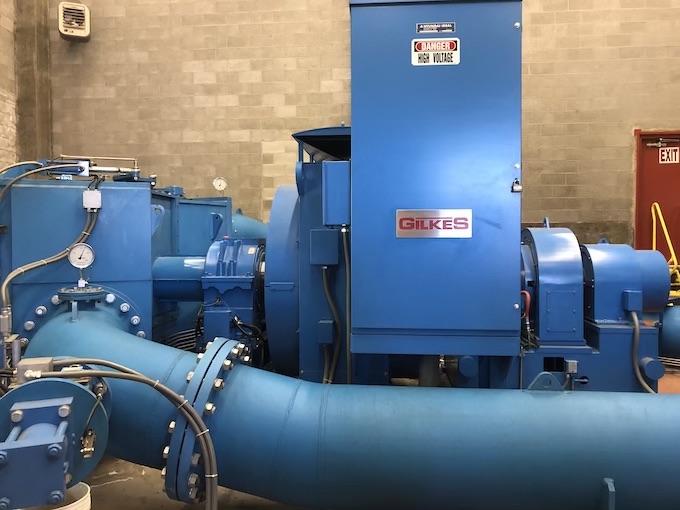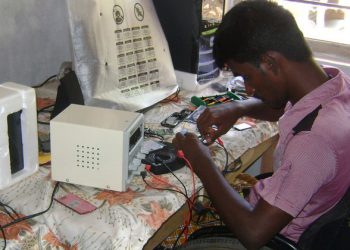On Monday, July 22, about 30 HydroVision attendees visited the beautiful Hood River Valley outside of Portland, Oregon to tour in-conduit hydropower projects and learn how modernizing irrigation districts is a sustainable solution to help combat a changing climate.
History
To understand the purpose of irrigation districts, you must first understand the climate in the Northwestern US, where apples, pears, cherries and other fine fruits are grown. While the land is lush, the lack of rain and underground aquifers makes it impossible for farmers to grow crops without irrigation, which is done by diverting water from the Hood River. This is usually done via open canals, which divert water from the river and, through gravity, deliver it to the farms. The East Fork irrigation district in the Hood River Valley delivers water that way. This was the first stop of the tour.
 The East Fork Irrigation District diversion has not been modernized.
The East Fork Irrigation District diversion has not been modernized.
The challenges with open canals, however, are many. Water is lost to evaporation and seepage, which can account for up to 50% of water losses in some cases. Plus, open systems are costly to maintain and are prone to flooding.
Modernizing the system
The modern solution to open canals is pipes and a pressurized water system. According to Jed Jorgensen, senior renewable energy program manager for Energy Trust of Oregon, who led attendees on the tour, this solution is much more efficient than individual pumps on each and every farm in the region.
“Where you’ve got surplus water in that system, where it’s pressurized, that’s where we start to get in-conduit hydropower,” said Jorgensen. “That’s what you’re going to see today.”
Attendees first visited the East Fork diversion to see how an example of a system that was not modernized and did not have hydropower generation facilities and then visited facilities that had been modernized.
In-conduit hydropower
In the early 80’s during what Farmer’s Irrigation District (FID) general manager Les Perkins said was a boom of small hydropower development, two districts developed hydropower. At the time, the utility avoided cost rate was somewhere near 15 cents per kWh, said Perkins, which made it advantageous to develop the systems. Today, it’s 2.2 cents per kWh, making it economically difficult to build new in-conduit hydropower systems today.
FID’s two systems with a nameplate capacity of 4.4 MW have allowed the region to benefit from 30 years of hydropower revenue. The money that is made goes right back into the system itself for O&M, with a bit left over to upgrade equipment as needed, Perkins explained.
 Les Perkins, General Manager of the Farmer’s Irrigation District talks to tour attendees during HydroVision.
Les Perkins, General Manager of the Farmer’s Irrigation District talks to tour attendees during HydroVision.
Repowering
In 2015, Farmers Plant 2 hydropower facility, re-powered its 3-MW two-turbine system that was installed in 1986 with a 2.6-MW Gilkes Turgo turbine (see lead image) to better manage the high silt load of their glacially fed water source. But even though the nameplate capacity when down, the output went up.
“We are able to produce quite a bit more electricity with this one unit, year round, because of the efficiency increases,” said Zach DeHart, hydropower operator for FID.
The powerhouse was also fully retrofitted with new controls and PLCs. DeHart said the new digital solution with the Turgo turbine is a dream to manage and has reduced maintenance time significantly. The old system cost upwards of $300,000 annually to keep running.
“The last time I pulled the cover off [the Turgo turbine] was last October and I could still see the grinding marks from the fabrication center,” said DeHart, adding “so it handles settlement incredibly well, which is a dream come true.”





